-
CATEGORY ::
- All Seeds /
- All Flower Seeds /
- All Gerbera Seeds


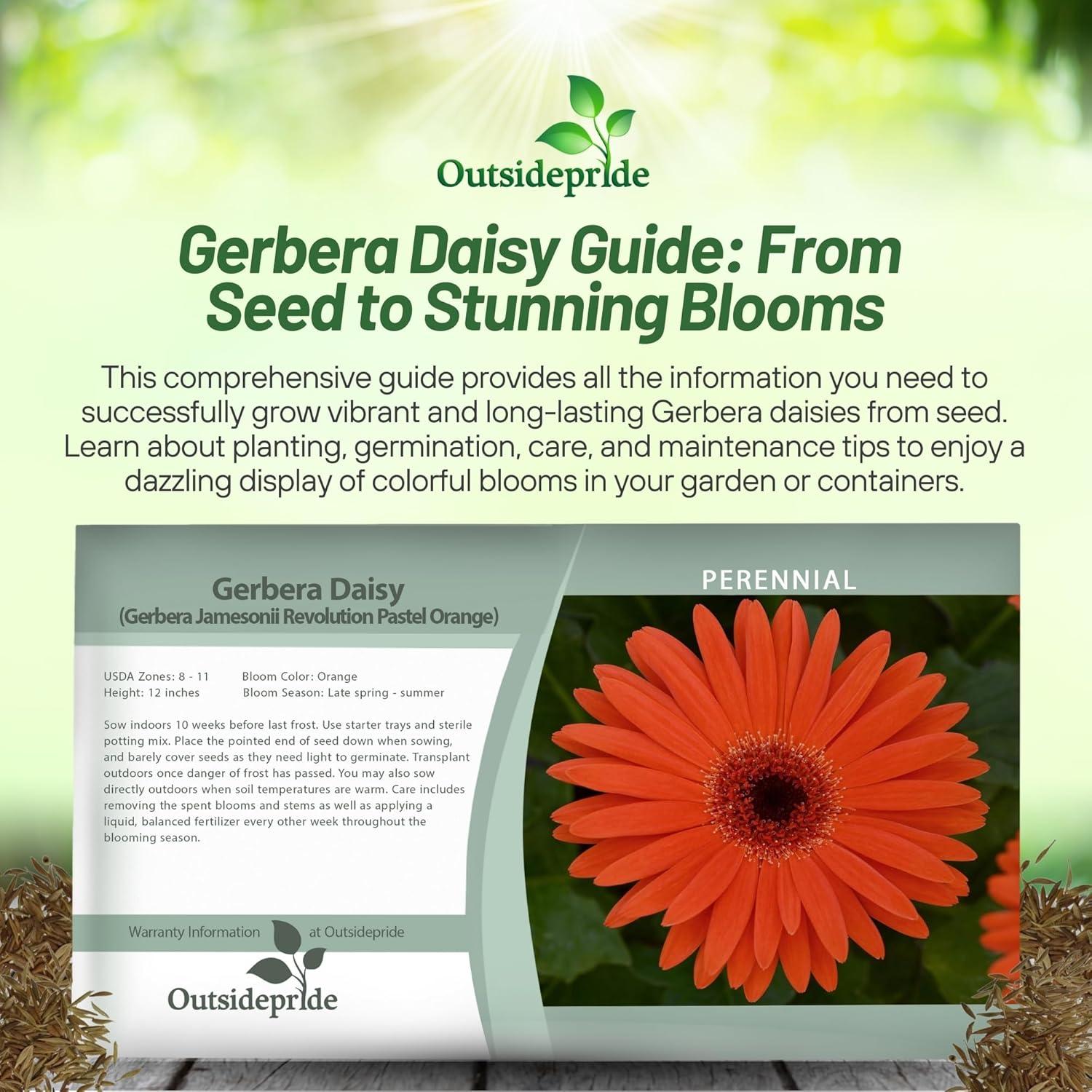
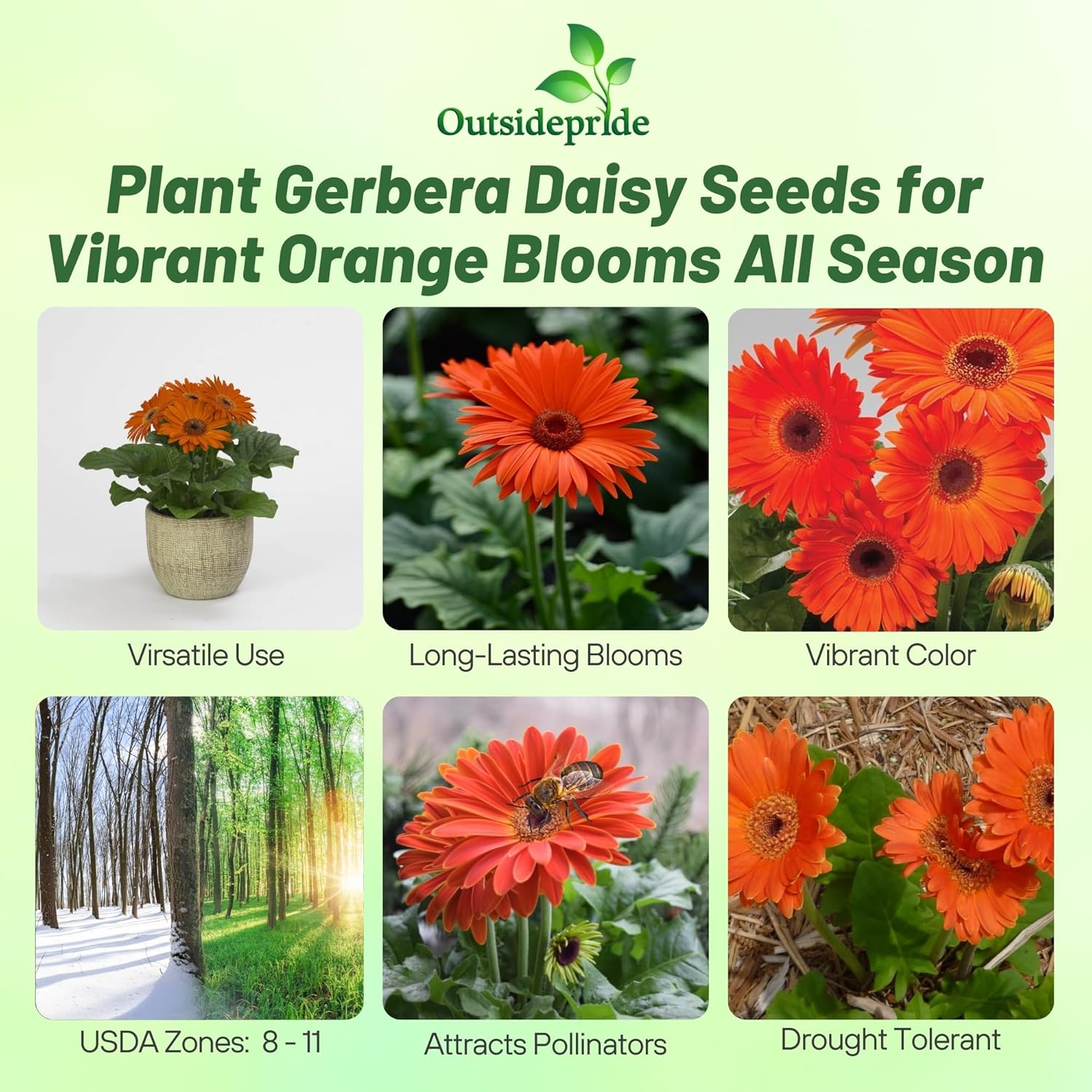
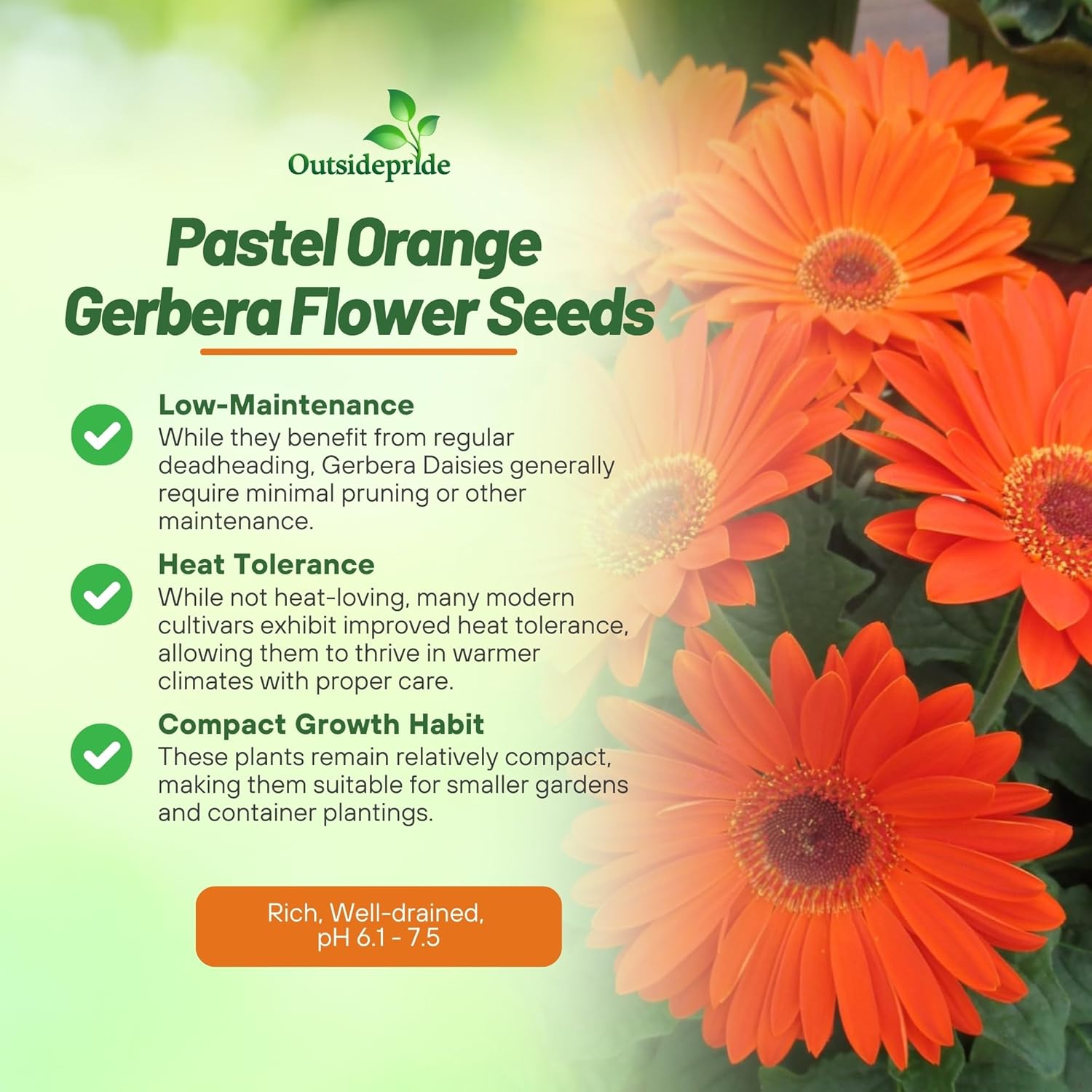
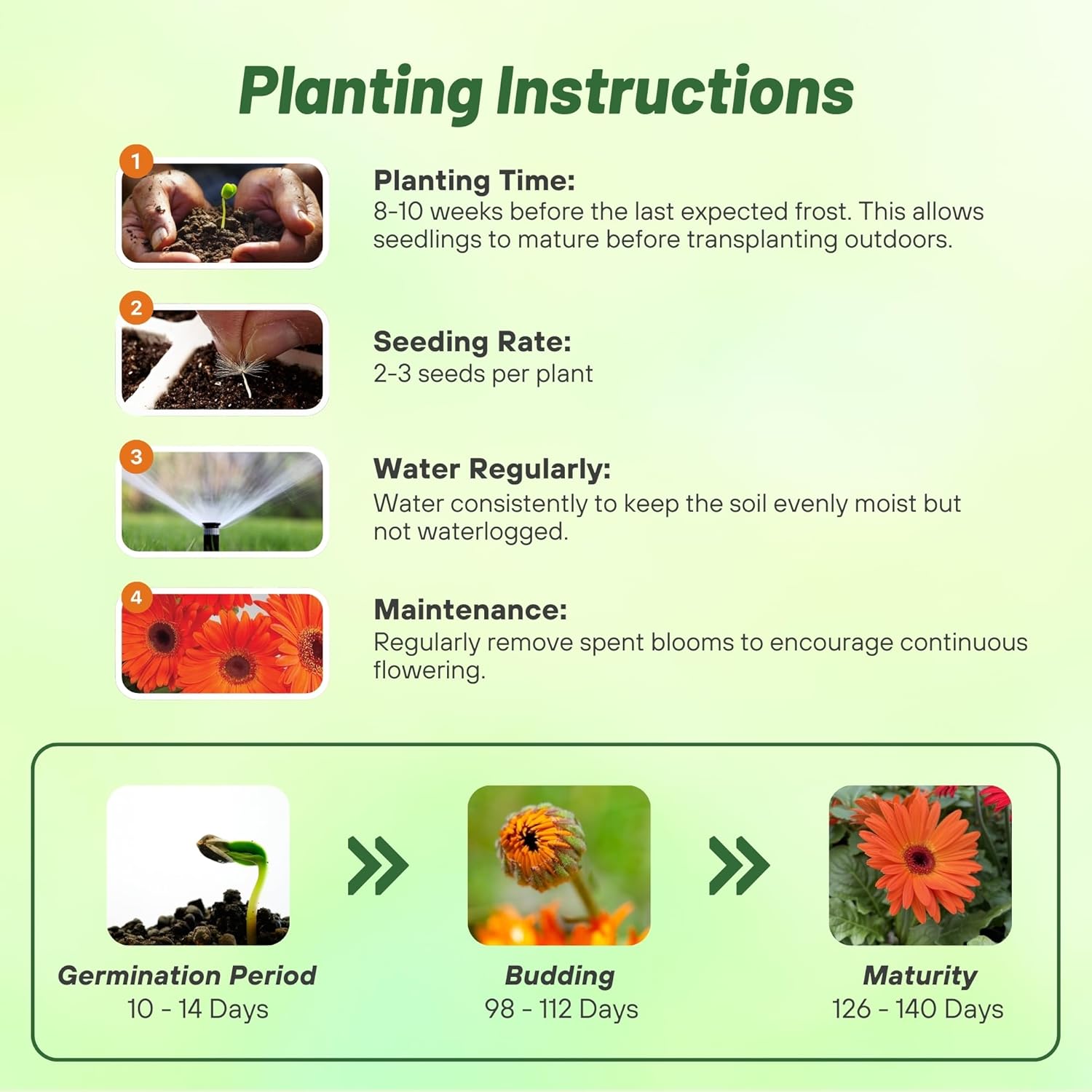



Gerbera Seeds - Orange
SEASON
Perennial
USDA ZONES
8 - 11
HEIGHT
8 - 10 inches
BLOOM SEASON
Late spring to late summer
BLOOM COLOR
Orange
ENVIRONMENT
Full sun to partial shade
SOIL TYPE
Rich, well-drained, pH 6.1 - 7.5
DEER RESISTANT
Yes
HOUSE PLANT
Yes
SEASON
Perennial
USDA ZONES
8 - 11
HEIGHT
10 - 14 inches
BLOOM SEASON
Late spring to late summer
BLOOM COLOR
Mix
ENVIRONMENT
Full sun to partial shade
SOIL TYPE
Rich, well-drained, pH 6.1 - 7.5
DEER RESISTANT
Yes
HOUSE PLANT
Yes
SEASON
Perennial
USDA ZONES
8 - 11
HEIGHT
8 - 10 inches
BLOOM SEASON
Late spring to late summer
BLOOM COLOR
Yellow
ENVIRONMENT
Full sun to partial shade
SOIL TYPE
Rich, well-drained, pH 6.1 - 7.5
DEER RESISTANT
Yes
HOUSE PLANT
Yes
SEASON
Perennial
USDA ZONES
8 - 11
HEIGHT
8 - 10 inches
BLOOM SEASON
Late spring to late summer
BLOOM COLOR
Pink
ENVIRONMENT
Full sun to partial shade
SOIL TYPE
Rich, well-drained, pH 6.1 - 7.5
DEER RESISTANT
Yes
HOUSE PLANT
Yes
SEASON
Perennial
USDA ZONES
8 - 11
HEIGHT
8 - 10 inches
BLOOM SEASON
Late spring to late summer
BLOOM COLOR
Red
ENVIRONMENT
Full sun to partial shade
SOIL TYPE
Rich, well-drained, pH 6.1 - 7.5
DEER RESISTANT
Yes
HOUSE PLANT
Yes
SEASON
Perennial
USDA ZONES
8 - 11
HEIGHT
8 - 10 inches
BLOOM SEASON
Late spring to late summer
BLOOM COLOR
Rose
ENVIRONMENT
Full sun to partial shade
SOIL TYPE
Rich, well-drained, pH 6.1 - 7.5
DEER RESISTANT
Yes
HOUSE PLANT
Yes
SEASON
Perennial
USDA ZONES
8 - 11
HEIGHT
8 - 10 inches
BLOOM SEASON
Late spring to late summer
BLOOM COLOR
White
ENVIRONMENT
Full sun to partial shade
SOIL TYPE
Rich, well-drained, pH 6.1 - 7.5
DEER RESISTANT
Yes
HOUSE PLANT
Yes
SEASON
Perennial
USDA ZONES
9 - 11
HEIGHT
16 - 18 inches
BLOOM SEASON
Spring through Autumn
BLOOM COLOR
Mix
ENVIRONMENT
Full sun to partial shade
SOIL TYPE
Rich, well-drained, pH 6.1 - 7.5
DEER RESISTANT
Yes
HOUSE PLANT
Yes
About...
Gerbera Daisy (Gerbera Jamesonii Revolution Pastel Orange) - Gerbera seed is very popular and grown by many gardeners who appreciate the bold, colorful Gerbera Daisy flowers. This orange daisy measures 4 inches across and looks stunning in pots, baskets and in the flower border as well.MORE GERBERA OPTIONS
Planting Directions
TEMPERATURE
70F
AVERAGE GERM TIME
10 - 21 days
LIGHT REQUIRED
Yes
DEPTH
Seeds must be covered thinly, no more than the thickness of the seed
SOWING RATE
2 - 3 seeds per plant
MOISTURE
Keep seed moist until germination
PLANT SPACING
10 - 15 inches

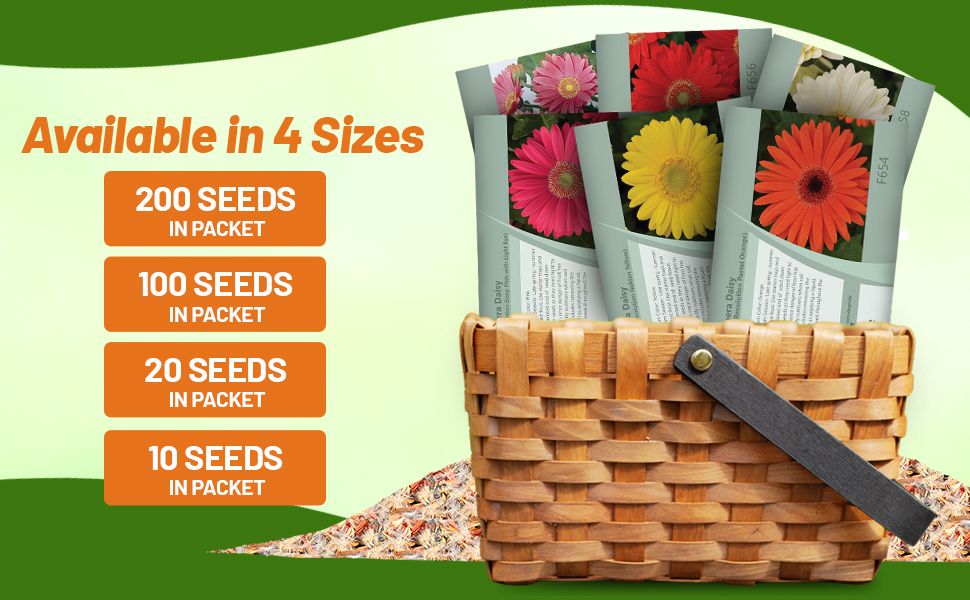
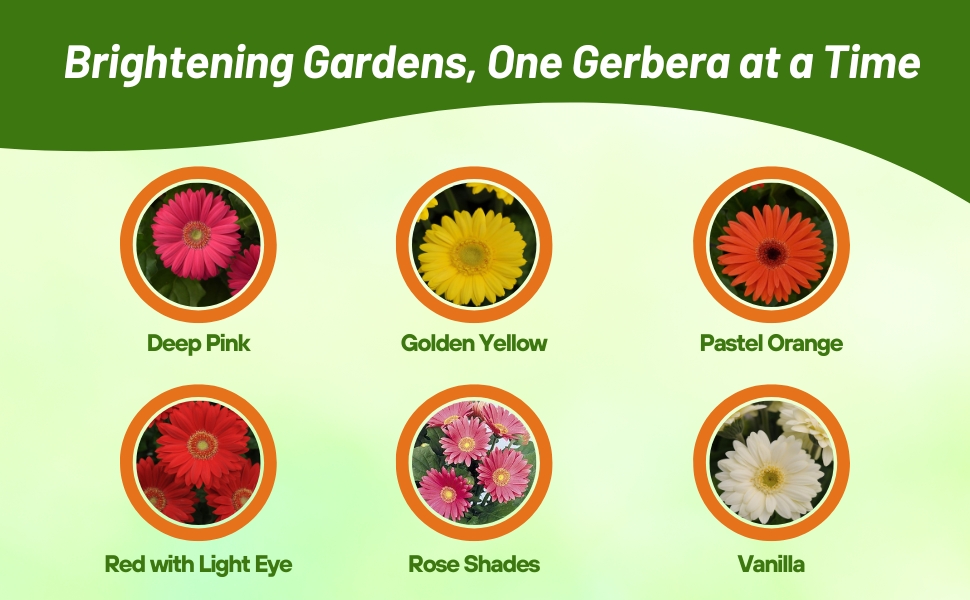
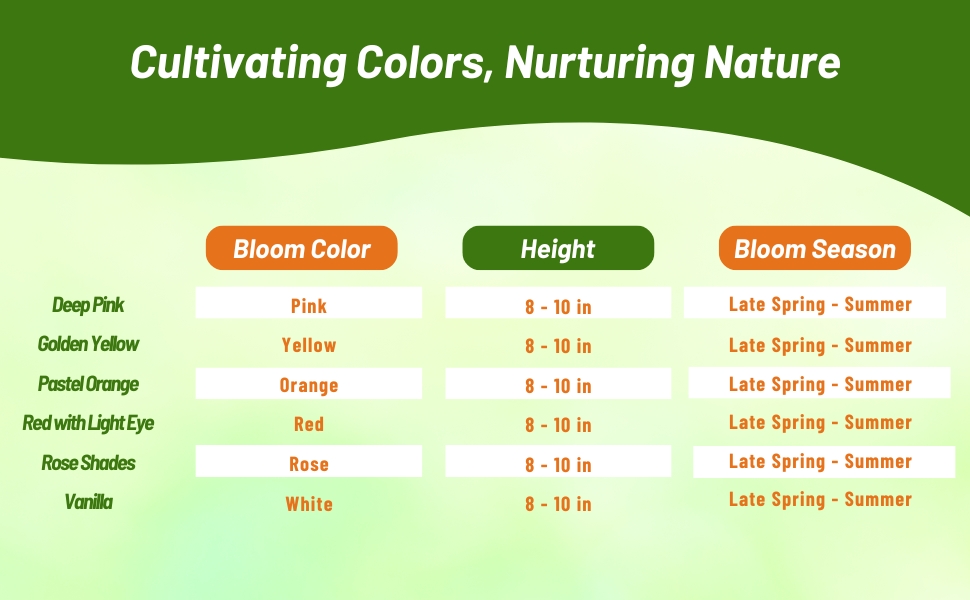
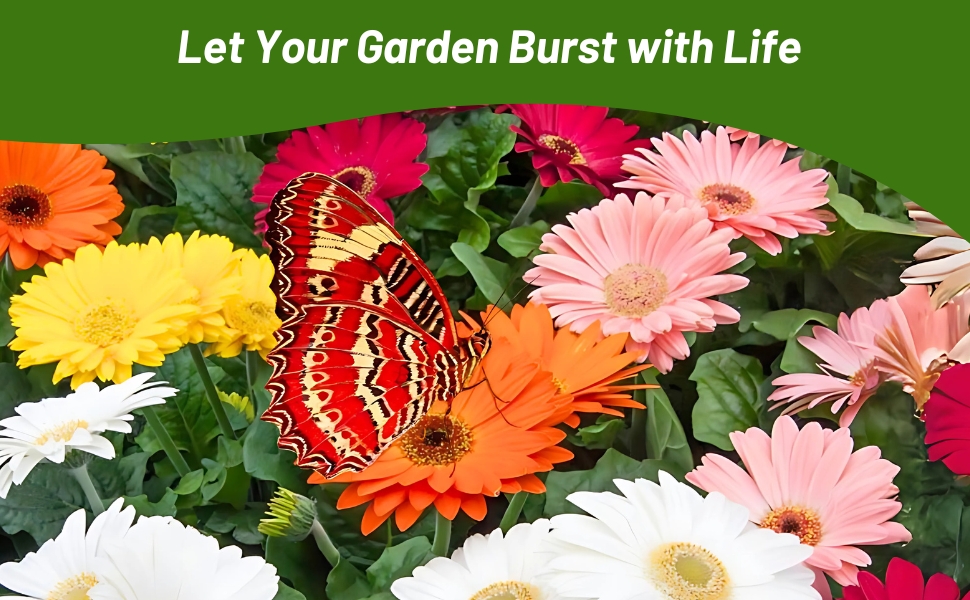
Gerbera Daisy (Gerbera Jamesonii Revolution Pastel Orange) - Gerbera seed is very popular and grown by many gardeners who appreciate the bold, colorful Gerbera Daisy flowers. This orange daisy measures 4 inches across and looks stunning in pots, baskets and in the flower border as well.
Gerbera Jamesonii plants are native to South Africa and are a tender perennial. They grow everywhere as a colorful annual, and have a tremendously long bloom season. Gerbera Daisy plants are also a good bedding item, and of course a mainstay of the cutting garden as well as an indoor house plant. The Gerbera Daisy flower loves full sun or partial shade and appreciates deep, rich soil with compost and other organics worked in.
Sow Gerbera Daisy seeds indoors 10 weeks before the last frost. Use starter trays and sterile potting mix. Place the pointed end of the flower seed down when sowing, and barely cover the seeds as they need light to germinate. Transplant outdoors once danger of frost has passed. You may also sow Gerbera Daisy seed directly outdoors when soil temperatures are warm. Gerbera Jamesonii care includes removing the spent blooms and stems as well as applying a liquid, balanced fertilizer every other week throughout the blooming season.
Common Questions
Can Gerbera daisies be grown indoors?
Gerbera daisies are commonly initiated indoors from seeds, but they thrive best when grown outdoors in the long run, requiring plenty of sunlight and nutrient-rich soil. Although Gerbera daisies are occasionally presented as potted gifts, they usually do not have a long lifespan or bloom repeatedly.
Are Gerbera daisies easy to grow?
Gerbera daisies can thrive outdoors with proper care. To grow them successfully, it's essential to monitor their water, light, and soil conditions diligently.
My plants are getting excessively bushy, what can I do?
If foliage is getting too bushy, remove some of the clustered center leaves to let in more sunlight.
How get I get my gerbera to give me more blooms?
Fertilizing your plants every 2 weeks with a high phosphorus, bloom boosting fertilizer can help. If you are amid summer the heat can suppress blooms, try moving them indoors until the hot weather passes.
My leaves are turning yellow, why?
Yellowing of lower leaves or the discoloration of plant tissue between green veins is often a sign of iron deficiency, which can impact flower production. This deficiency may stem from insufficient iron in the soil or fertilizer, or a soil pH above 6.2. Factors like temperatures below 68 degrees F, waterlogged soil, and unhealthy roots can also hinder nutrient absorption. Monitor temperatures, soil moisture, pH levels, and root condition to identify the underlying issue. Adjust soil pH if necessary or introduce iron chelates. Remember to avoid overwatering to maintain plant health.
Do I need to prune my gerbera plants?
Deadheading will extend your bloom season. As blooms fade, deadhead or prune the flower stems to the leaves where they emerge. Also to keep your plants looking tidy and encourage new leaf growth, pinch or trim older fading leaves.
Planting Directions
TEMPERATURE
70F
AVERAGE GERM TIME
10 - 21 days
LIGHT REQUIRED
Yes
DEPTH
Seeds must be covered thinly, no more than the thickness of the seed
SOWING RATE
2 - 3 seeds per plant
MOISTURE
Keep seed moist until germination
PLANT SPACING
12 - 16 inches

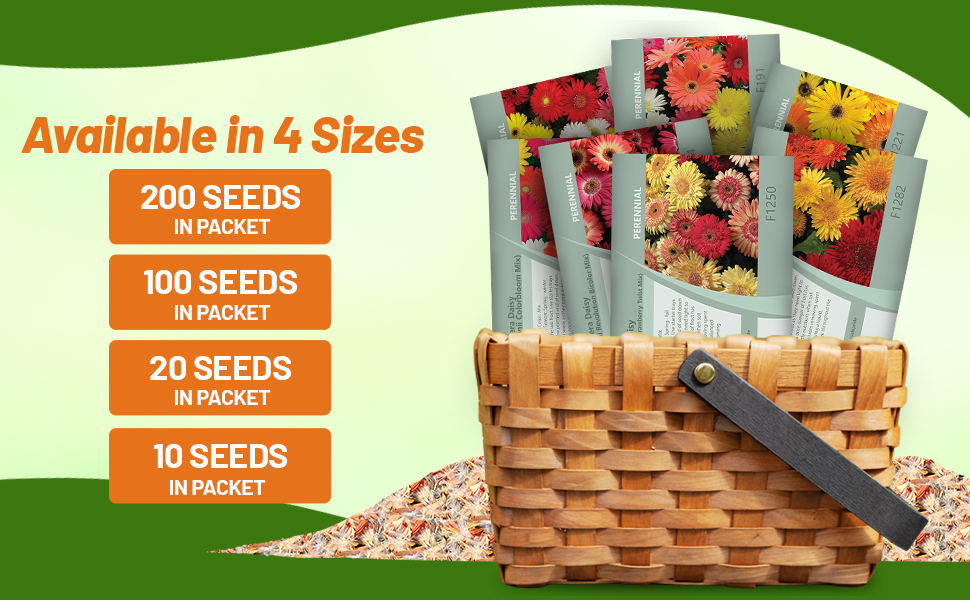
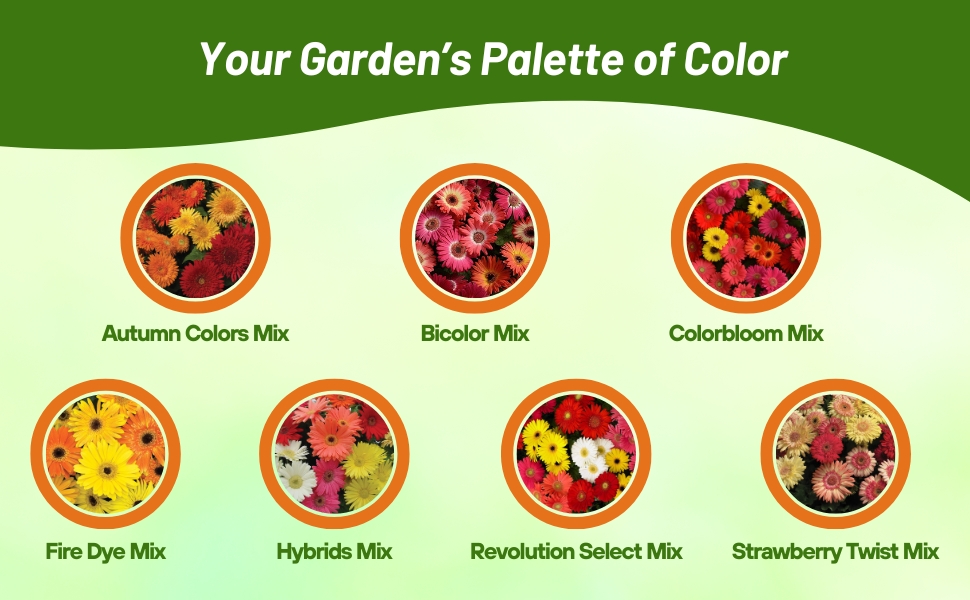
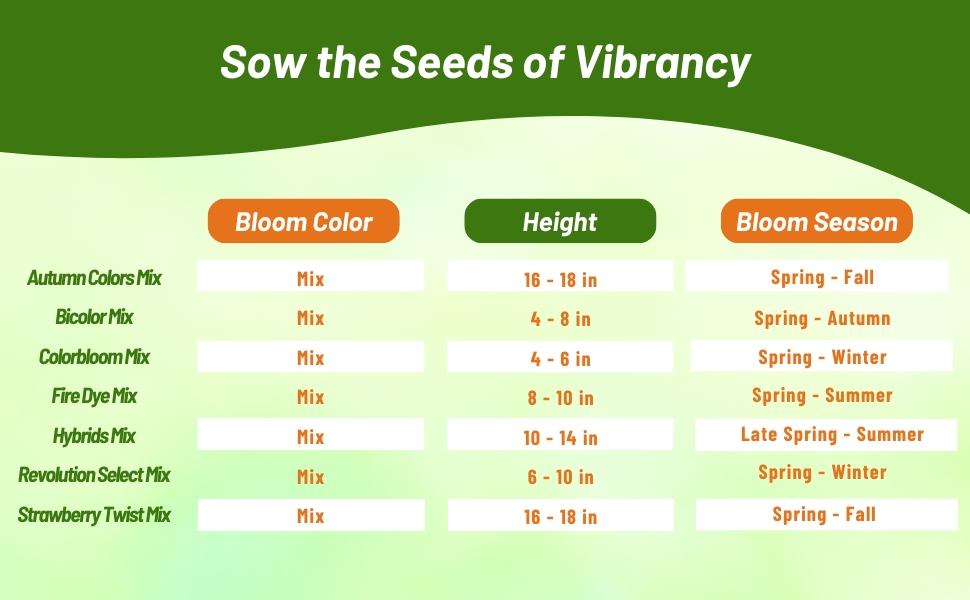

Gerbera Daisy (Gerbera Jamesonii Hybrids Mix) - This mix of flowering daisies is so impressive your neighbors will all be asking where you got this beautiful mix. You can tell them that you grew your own Gerbera Daisies from flower seed! This Gerbera flower seed mix produces compact plants scarcely a foot high and not as wide with gorgeous, large blooms on pencil-thick stems.
Originally only available in a handful of colors, the Gerbera Jamesonii plant has been hybridized to produce hundreds of varieties in all colors of the rainbow. This Gerbera flower seed mix contains beautiful flowers which measure 3 1/2 - 4 inches wide. They appear above the large, lovely dark green foliage on compact, sturdy little plants that bloom just 14 weeks after sowing Gerbera Daisy seeds. Gerbera Daisy flowers are very long-lasting after cutting so you can take them inside and enjoy their beauty as well.
Gerbera Daisy plants are a tender perennial. They grow everywhere as a colorful annual, and have a tremendously long bloom season. They are also a good bedding item, and of course a mainstay of the cutting garden. The flowers loves full sun and appreciates deep, rich soil, so work in compost and other organics and keep the water coming.
Sow Gerbera Daisy seeds indoors 8 - 10 weeks before the last frost. Use starter trays and sterile potting mix. Place the pointed end of the flower seed down when sowing, and barely cover the seeds as they need light to germinate. Transplant outdoors once danger of frost has passed. You may also sow Gerbera Daisy seeds directly outdoors when soil temperatures are warm.
Common Questions
Can Gerbera daisies be grown indoors?
Gerbera daisies are commonly initiated indoors from seeds, but they thrive best when grown outdoors in the long run, requiring plenty of sunlight and nutrient-rich soil. Although Gerbera daisies are occasionally presented as potted gifts, they usually do not have a long lifespan or bloom repeatedly.
Are Gerbera daisies easy to grow?
Gerbera daisies can thrive outdoors with proper care. To grow them successfully, it's essential to monitor their water, light, and soil conditions diligently.
My plants are getting excessively bushy, what can I do?
If foliage is getting too bushy, remove some of the clustered center leaves to let in more sunlight.
How get I get my gerbera to give me more blooms?
Fertilizing your plants every 2 weeks with a high phosphorus, bloom boosting fertilizer can help. If you are amid summer the heat can suppress blooms, try moving them indoors until the hot weather passes.
My leaves are turning yellow, why?
Yellowing of lower leaves or the discoloration of plant tissue between green veins is often a sign of iron deficiency, which can impact flower production. This deficiency may stem from insufficient iron in the soil or fertilizer, or a soil pH above 6.2. Factors like temperatures below 68 degrees F, waterlogged soil, and unhealthy roots can also hinder nutrient absorption. Monitor temperatures, soil moisture, pH levels, and root condition to identify the underlying issue. Adjust soil pH if necessary or introduce iron chelates. Remember to avoid overwatering to maintain plant health.
Do I need to prune my gerbera plants?
Deadheading will extend your bloom season. As blooms fade, deadhead or prune the flower stems to the leaves where they emerge. Also to keep your plants looking tidy and encourage new leaf growth, pinch or trim older fading leaves.
Planting Directions
TEMPERATURE
70F
AVERAGE GERM TIME
10 - 21 days
LIGHT REQUIRED
Yes
DEPTH
Seeds must be covered thinly, no more than the thickness of the seed
SOWING RATE
2 - 3 seeds per plant
MOISTURE
Keep seed moist until germination
PLANT SPACING
10 - 15 inches

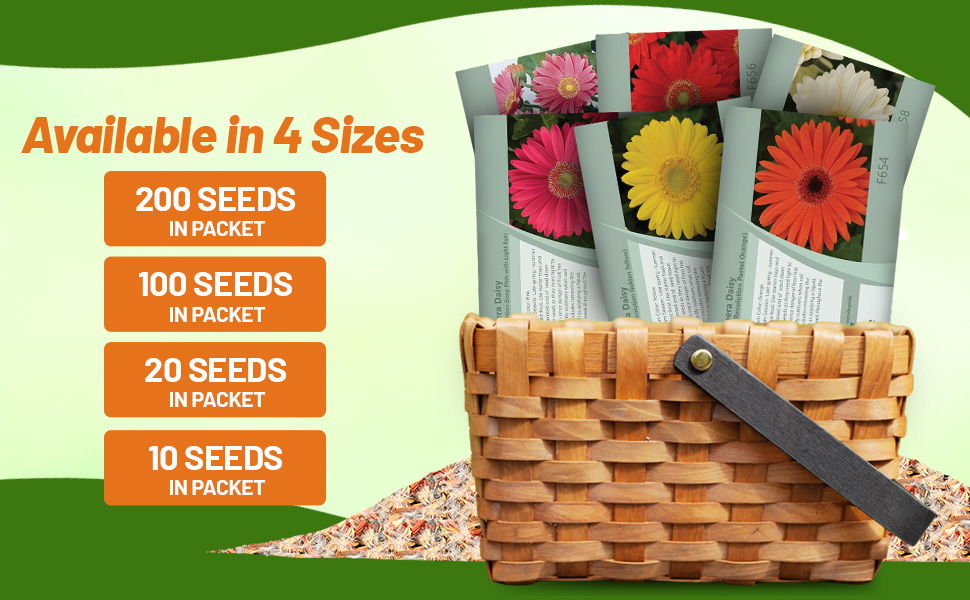

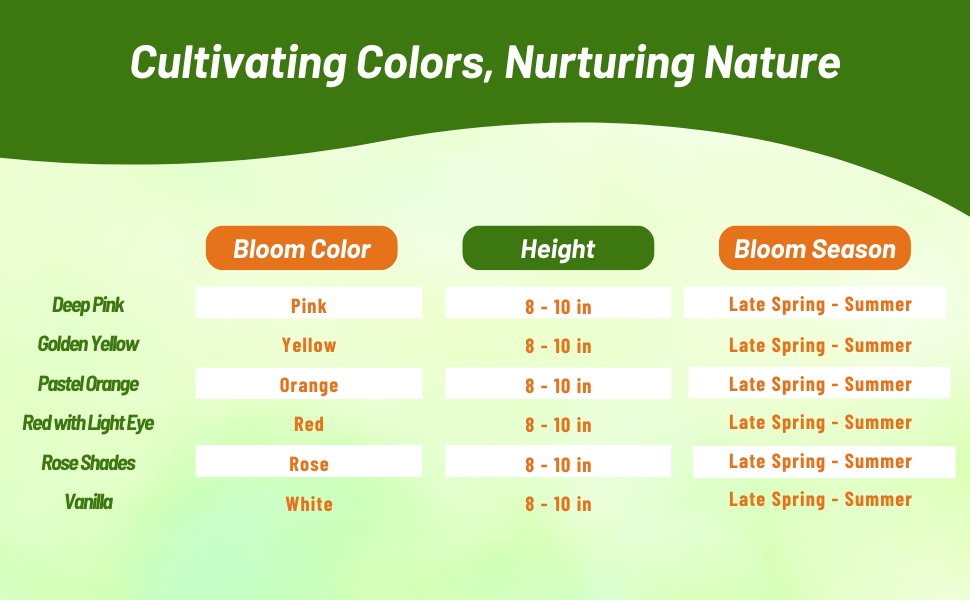
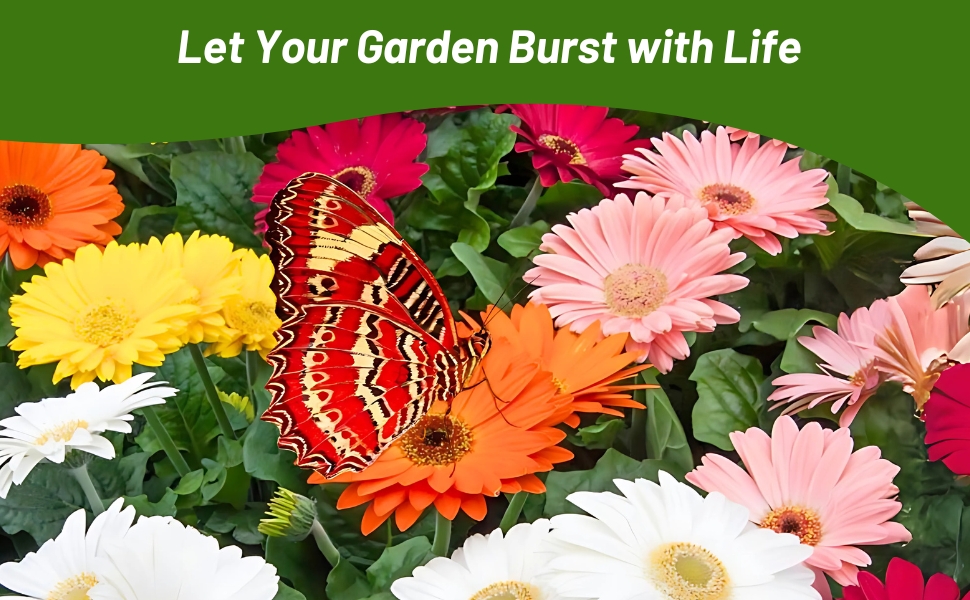
Gerbera Daisy (Gerbera Jamesonii Revolution Golden Yellow) - Gerbera seeds are easy to grow, and the beautiful, bold flowers are worth the effort! This golden yellow Gerbera Daisy flower is 4 inches across and a dazzling performer. Gerbera Jamesonii plants are native to South Africa, and they will grow as perennials in frost-free zones.
Common Questions
Can Gerbera daisies be grown indoors?
Gerbera daisies are commonly initiated indoors from seeds, but they thrive best when grown outdoors in the long run, requiring plenty of sunlight and nutrient-rich soil. Although Gerbera daisies are occasionally presented as potted gifts, they usually do not have a long lifespan or bloom repeatedly.
Are Gerbera daisies easy to grow?
Gerbera daisies can thrive outdoors with proper care. To grow them successfully, it's essential to monitor their water, light, and soil conditions diligently.
My plants are getting excessively bushy, what can I do?
If foliage is getting too bushy, remove some of the clustered center leaves to let in more sunlight.
How get I get my gerbera to give me more blooms?
Fertilizing your plants every 2 weeks with a high phosphorus, bloom boosting fertilizer can help. If you are amid summer the heat can suppress blooms, try moving them indoors until the hot weather passes.
My leaves are turning yellow, why?
Yellowing of lower leaves or the discoloration of plant tissue between green veins is often a sign of iron deficiency, which can impact flower production. This deficiency may stem from insufficient iron in the soil or fertilizer, or a soil pH above 6.2. Factors like temperatures below 68 degrees F, waterlogged soil, and unhealthy roots can also hinder nutrient absorption. Monitor temperatures, soil moisture, pH levels, and root condition to identify the underlying issue. Adjust soil pH if necessary or introduce iron chelates. Remember to avoid overwatering to maintain plant health.
Do I need to prune my gerbera plants?
Deadheading will extend your bloom season. As blooms fade, deadhead or prune the flower stems to the leaves where they emerge. Also to keep your plants looking tidy and encourage new leaf growth, pinch or trim older fading leaves.
Planting Directions
TEMPERATURE
70F
AVERAGE GERM TIME
10 - 21 days
LIGHT REQUIRED
Yes
DEPTH
Seeds must be covered thinly, no more than the thickness of the seed
SOWING RATE
2 - 3 seeds per plant
MOISTURE
Keep seed moist until germination
PLANT SPACING
10 - 15 inches

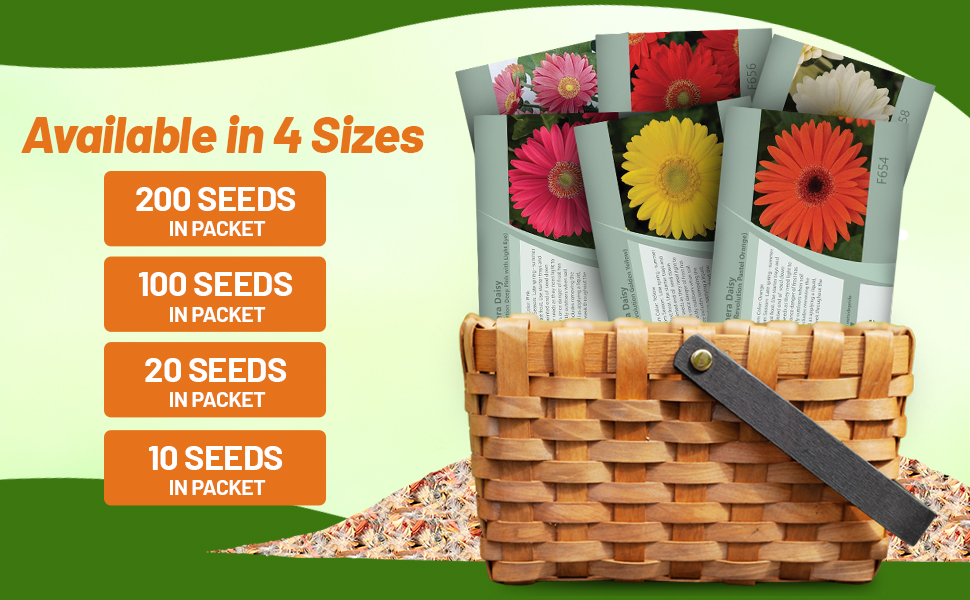
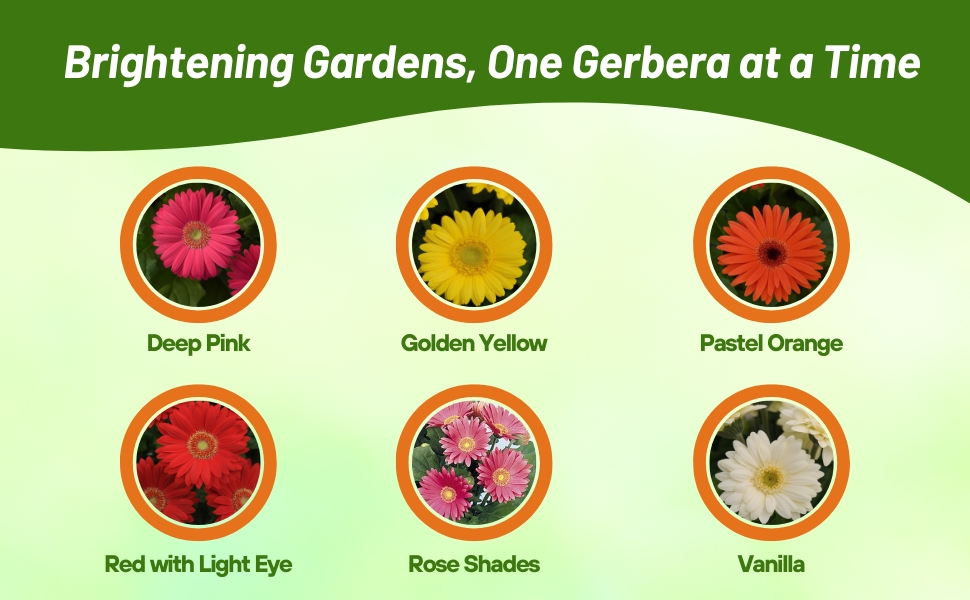
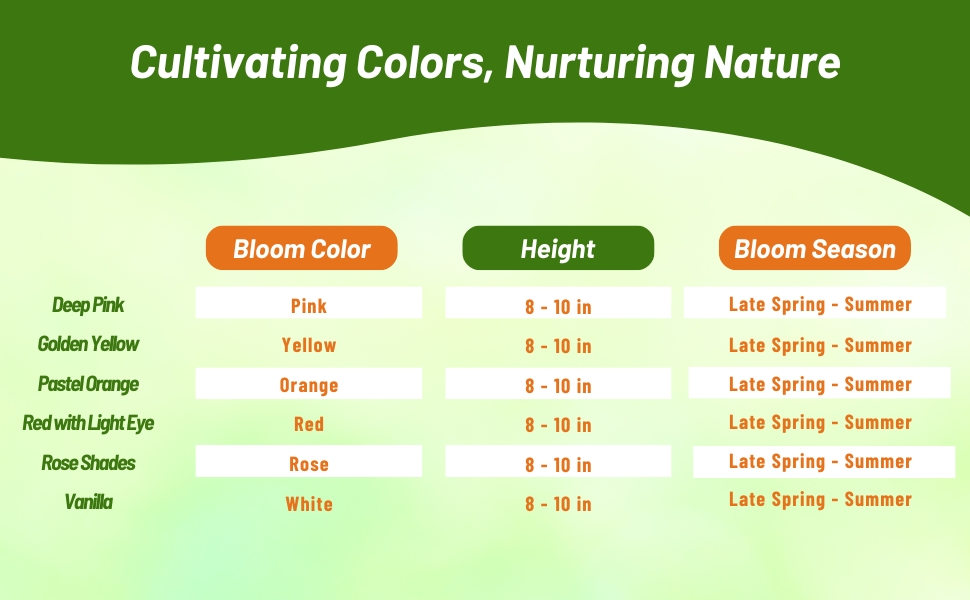

Gerbera Daisy (Gerbera Jamesonii Revolution Pink w/ Green Center) - This native of South Africa can be grown from Gerbera seeds. Gerbera Jamesonii plants are perennial in frost free zones, but can easily be grown as annuals in colder climates. This pink Gerbera Daisy flower is so sweet and lovely. Grow it in the house in a sunny south window. As a house plant, Gerbera Daisy plants can bloom for about 6 weeks.
Gerbera Jamesonii plants are a good bedding item, and of course a mainstay of the cutting garden. The Gerbera Daisy flower loves full sun or partial shade and appreciates deep, rich soil. Therefore, working in compost and other organics is helpful, and keep the soil evenly moist.
Sow Gerbera Daisy seeds indoors 10 weeks before the last frost. Use starter trays and sterile potting mix. Place the pointed end of the flower seed down when sowing, and barely cover the seeds as they need light to germinate. Transplant outdoors once danger of frost has passed. You may also sow Gerbera Daisy seed directly outdoors when soil temperatures are warm. Gerbera Jamesonii care includes removing the spent blooms and stems as well as applying a liquid, balanced fertilizer every other week throughout the blooming season. This beautiful photo is from town-n-country-living.com.
Common Questions
Can Gerbera daisies be grown indoors?
Gerbera daisies are commonly initiated indoors from seeds, but they thrive best when grown outdoors in the long run, requiring plenty of sunlight and nutrient-rich soil. Although Gerbera daisies are occasionally presented as potted gifts, they usually do not have a long lifespan or bloom repeatedly.
Are Gerbera daisies easy to grow?
Gerbera daisies can thrive outdoors with proper care. To grow them successfully, it's essential to monitor their water, light, and soil conditions diligently.
My plants are getting excessively bushy, what can I do?
If foliage is getting too bushy, remove some of the clustered center leaves to let in more sunlight.
How get I get my gerbera to give me more blooms?
Fertilizing your plants every 2 weeks with a high phosphorus, bloom boosting fertilizer can help. If you are amid summer the heat can suppress blooms, try moving them indoors until the hot weather passes.
My leaves are turning yellow, why?
Yellowing of lower leaves or the discoloration of plant tissue between green veins is often a sign of iron deficiency, which can impact flower production. This deficiency may stem from insufficient iron in the soil or fertilizer, or a soil pH above 6.2. Factors like temperatures below 68 degrees F, waterlogged soil, and unhealthy roots can also hinder nutrient absorption. Monitor temperatures, soil moisture, pH levels, and root condition to identify the underlying issue. Adjust soil pH if necessary or introduce iron chelates. Remember to avoid overwatering to maintain plant health.
Do I need to prune my gerbera plants?
Deadheading will extend your bloom season. As blooms fade, deadhead or prune the flower stems to the leaves where they emerge. Also to keep your plants looking tidy and encourage new leaf growth, pinch or trim older fading leaves.
Planting Directions
TEMPERATURE
70F
AVERAGE GERM TIME
10 - 21 days
LIGHT REQUIRED
Yes
DEPTH
Seeds must be covered thinly, no more than the thickness of the seed
SOWING RATE
2 - 3 seeds per plant
MOISTURE
Keep seed moist until germination
PLANT SPACING
10 - 15 inches

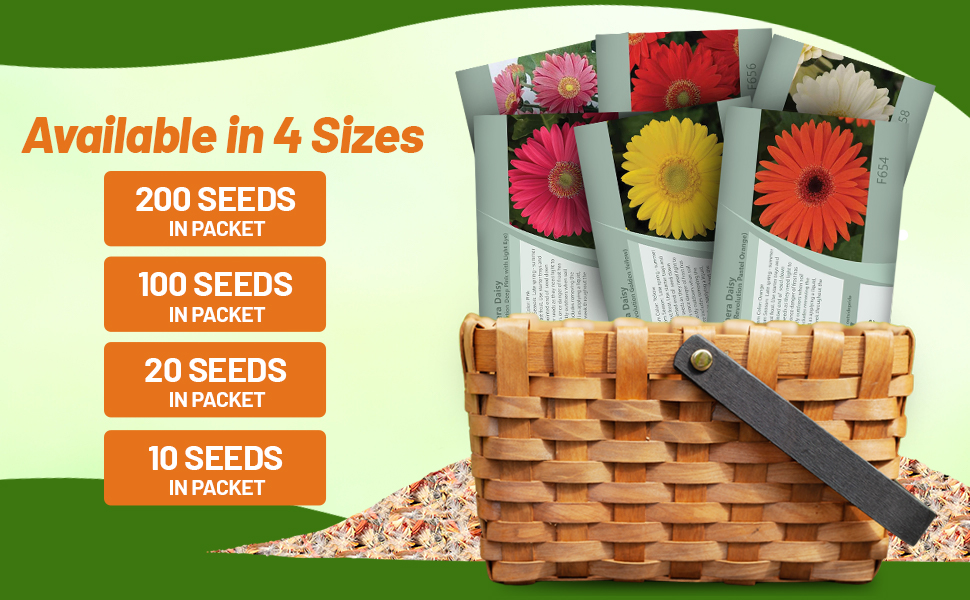

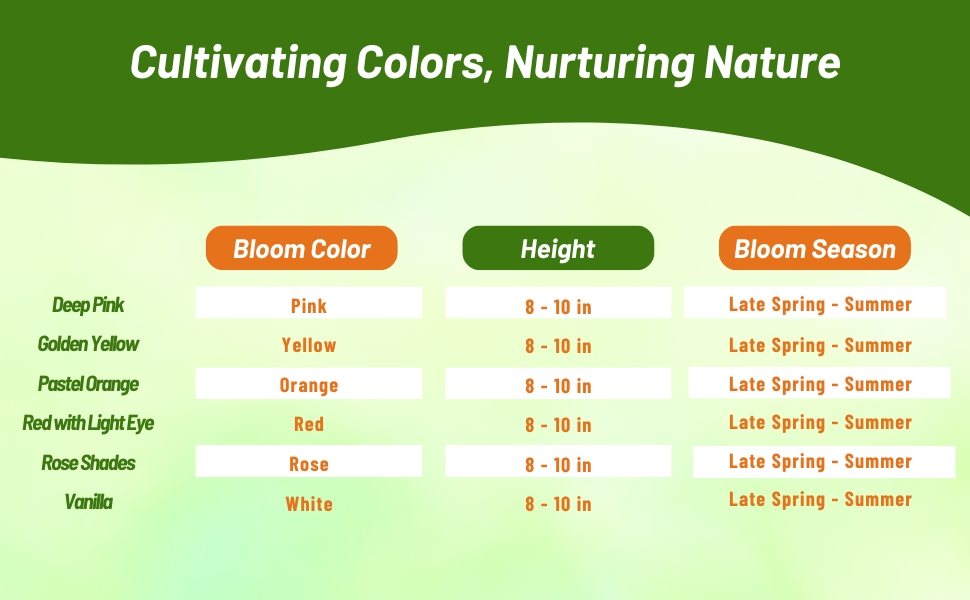

Gerbera Daisy (Gerbera Jamesonii Revolution Red w/ Light Eye) - Nothing demands more attention in the flower bed than this red Gerbera Daisy! Your neighbors will admire these flowers, and you will know that you grew them from Gerber seeds! With mounding foliage that is slightly hairy, thick strong stems, and 4 - 5 inch dazzling red blooms, this Gerbera Daisy is a main stay for the sunny flower bed.
Gerbera Jamesonii plants are native to South Africa and are a tender perennial. They grow everywhere as a colorful annual, and have a tremendously long bloom season. Gerbera Daisy plants are also a good bedding item, and of course a mainstay of the cutting garden as well as an indoor house plant. The Gerbera Daisy flower loves full sun or partial shade and appreciates deep, rich soil with compost and other organics worked in.
Sow Gerbera Daisy seeds indoors 10 weeks before the last frost. Use starter trays and sterile potting mix. Place the pointed end of the flower seed down when sowing, and barely cover the seeds as they need light to germinate. Transplant outdoors once danger of frost has passed. You may also sow Gerbera Daisy seed directly outdoors when soil temperatures are warm. Gerbera Jamesonii care includes removing the spent blooms and stems as well as applying a liquid, balanced fertilizer every other week throughout the blooming season.
Common Questions
Can Gerbera daisies be grown indoors?
Gerbera daisies are commonly initiated indoors from seeds, but they thrive best when grown outdoors in the long run, requiring plenty of sunlight and nutrient-rich soil. Although Gerbera daisies are occasionally presented as potted gifts, they usually do not have a long lifespan or bloom repeatedly.
Are Gerbera daisies easy to grow?
Gerbera daisies can thrive outdoors with proper care. To grow them successfully, it's essential to monitor their water, light, and soil conditions diligently.
My plants are getting excessively bushy, what can I do?
If foliage is getting too bushy, remove some of the clustered center leaves to let in more sunlight.
How get I get my gerbera to give me more blooms?
Fertilizing your plants every 2 weeks with a high phosphorus, bloom boosting fertilizer can help. If you are amid summer the heat can suppress blooms, try moving them indoors until the hot weather passes.
My leaves are turning yellow, why?
Yellowing of lower leaves or the discoloration of plant tissue between green veins is often a sign of iron deficiency, which can impact flower production. This deficiency may stem from insufficient iron in the soil or fertilizer, or a soil pH above 6.2. Factors like temperatures below 68 degrees F, waterlogged soil, and unhealthy roots can also hinder nutrient absorption. Monitor temperatures, soil moisture, pH levels, and root condition to identify the underlying issue. Adjust soil pH if necessary or introduce iron chelates. Remember to avoid overwatering to maintain plant health.
Do I need to prune my gerbera plants?
Deadheading will extend your bloom season. As blooms fade, deadhead or prune the flower stems to the leaves where they emerge. Also to keep your plants looking tidy and encourage new leaf growth, pinch or trim older fading leaves.
Planting Directions
TEMPERATURE
70F
AVERAGE GERM TIME
10 - 21 days
LIGHT REQUIRED
Yes
DEPTH
Seeds must be covered thinly, no more than the thickness of the seed
SOWING RATE
2 - 3 seeds per plant
MOISTURE
Keep seed moist until germination
PLANT SPACING
10 - 15 inches

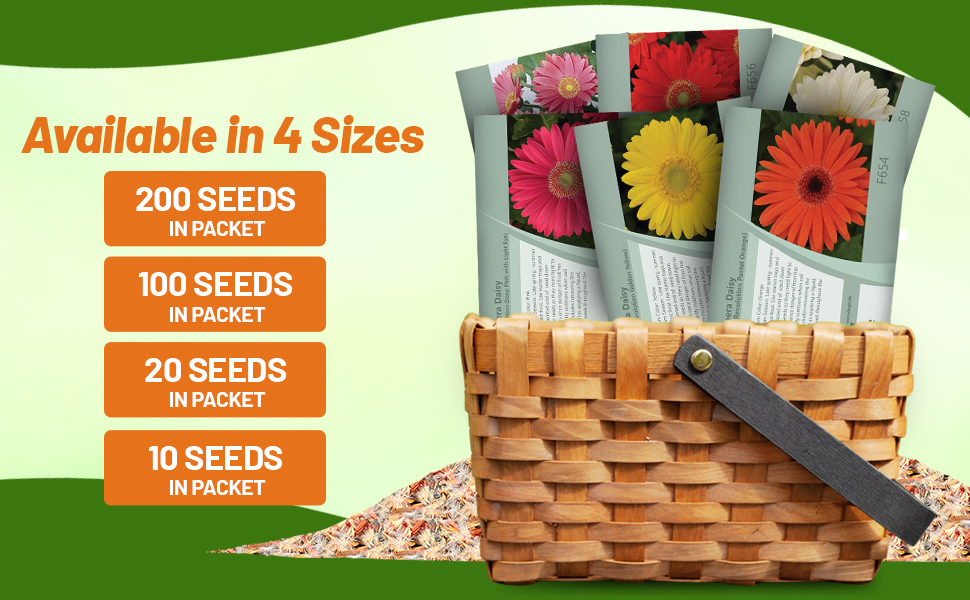
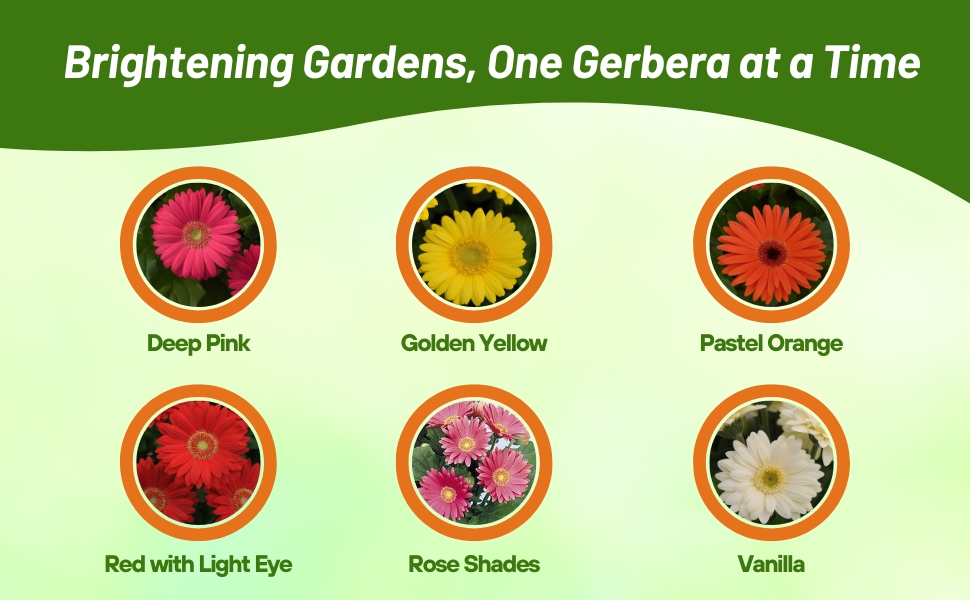
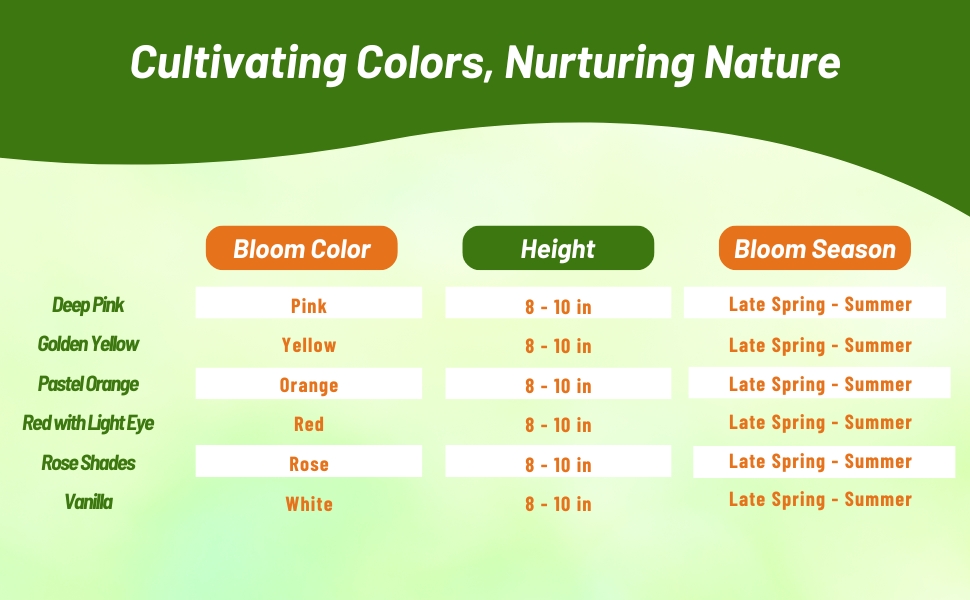
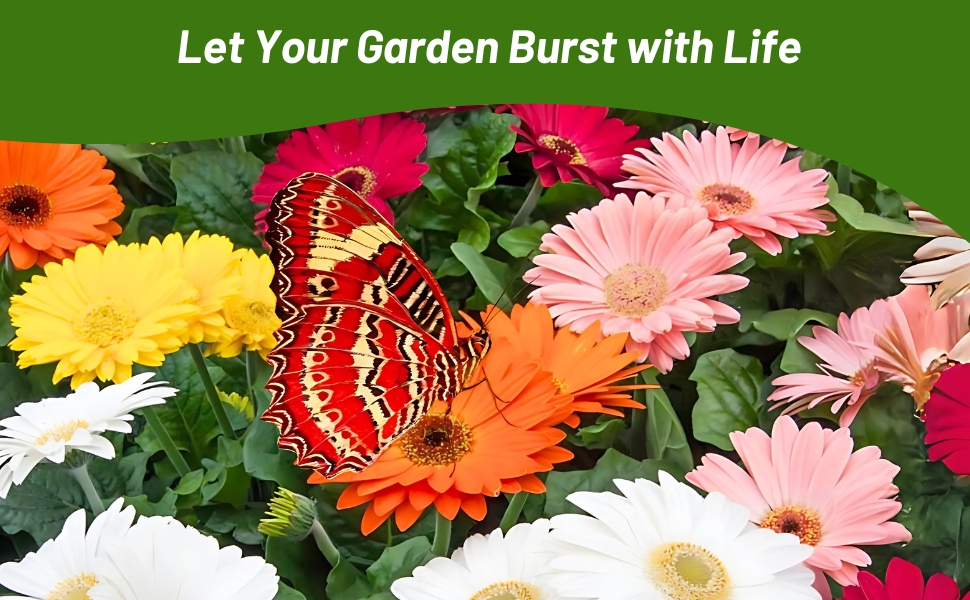
Gerbera Daisy (Gerbera Jamesonii Revolution Rose Shades) - Start Gerbera seed this winter and transplant these lovely Gerbera Daisy plants all through your landscape. This rose Gerbera Daisy flower is 4 inches across, forms on thick, strong stems, and the foliage is mounding with rich green leaves that are slightly hairy. Gerbera Daisies are perfect for pots, baskets, and in the flower bed. Gerbera Jamesonii plants are native to South Africa, and they will grow as perennials in frost-free zones.
Gerbera Jamesonii plants are a tender perennial. They grow everywhere as a colorful annual, and have a tremendously long bloom season. They are also a good bedding item, and of course a mainstay of the cutting garden. The Gerbera Daisy flower loves full sun or partial shade and appreciates deep, rich soil. Therefore, working in compost and other organics is helpful, and keep the soil evenly moist.
Sow Gerbera Daisy seeds indoors 10 weeks before the last frost. Use starter trays and sterile potting mix. Place the pointed end of the flower seed down when sowing, and barely cover the seeds as they need light to germinate. Transplant outdoors once danger of frost has passed. You may also sow Gerbera Daisy seed directly outdoors when soil temperatures are warm. Gerbera Jamesonii care includes removing the spent blooms and stems as well as applying a liquid, balanced fertilizer every other week throughout the blooming season.
Common Questions
Can Gerbera daisies be grown indoors?
Gerbera daisies are commonly initiated indoors from seeds, but they thrive best when grown outdoors in the long run, requiring plenty of sunlight and nutrient-rich soil. Although Gerbera daisies are occasionally presented as potted gifts, they usually do not have a long lifespan or bloom repeatedly.
Are Gerbera daisies easy to grow?
Gerbera daisies can thrive outdoors with proper care. To grow them successfully, it's essential to monitor their water, light, and soil conditions diligently.
My plants are getting excessively bushy, what can I do?
If foliage is getting too bushy, remove some of the clustered center leaves to let in more sunlight.
How get I get my gerbera to give me more blooms?
Fertilizing your plants every 2 weeks with a high phosphorus, bloom boosting fertilizer can help. If you are amid summer the heat can suppress blooms, try moving them indoors until the hot weather passes.
My leaves are turning yellow, why?
Yellowing of lower leaves or the discoloration of plant tissue between green veins is often a sign of iron deficiency, which can impact flower production. This deficiency may stem from insufficient iron in the soil or fertilizer, or a soil pH above 6.2. Factors like temperatures below 68 degrees F, waterlogged soil, and unhealthy roots can also hinder nutrient absorption. Monitor temperatures, soil moisture, pH levels, and root condition to identify the underlying issue. Adjust soil pH if necessary or introduce iron chelates. Remember to avoid overwatering to maintain plant health.
Do I need to prune my gerbera plants?
Deadheading will extend your bloom season. As blooms fade, deadhead or prune the flower stems to the leaves where they emerge. Also to keep your plants looking tidy and encourage new leaf growth, pinch or trim older fading leaves.
Planting Directions
TEMPERATURE
70F
AVERAGE GERM TIME
10 - 21 days
LIGHT REQUIRED
Yes
DEPTH
Seeds must be covered thinly, no more than the thickness of the seed
SOWING RATE
2 - 3 seeds per plant
MOISTURE
Keep seed moist until germination
PLANT SPACING
10 - 15 inches

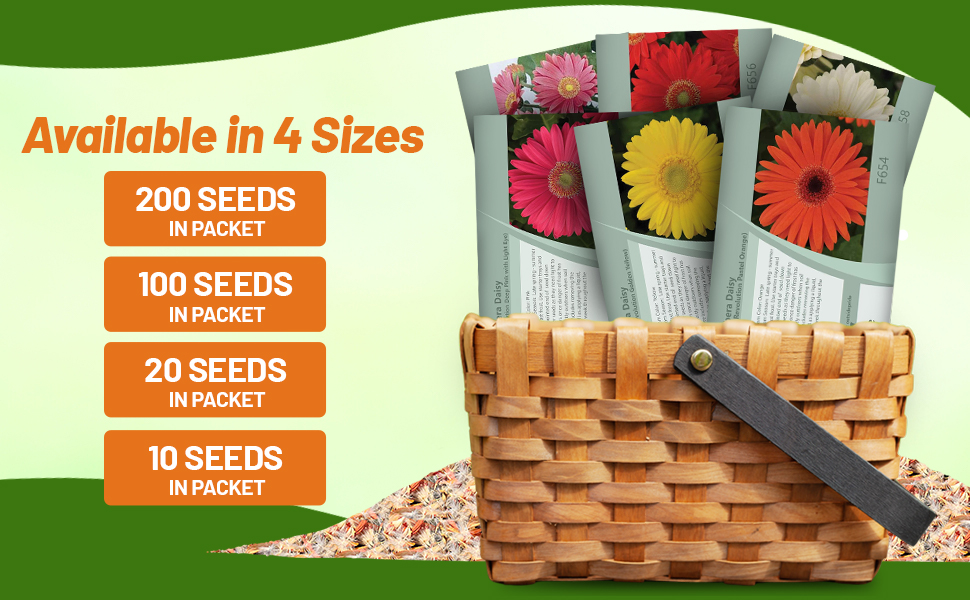
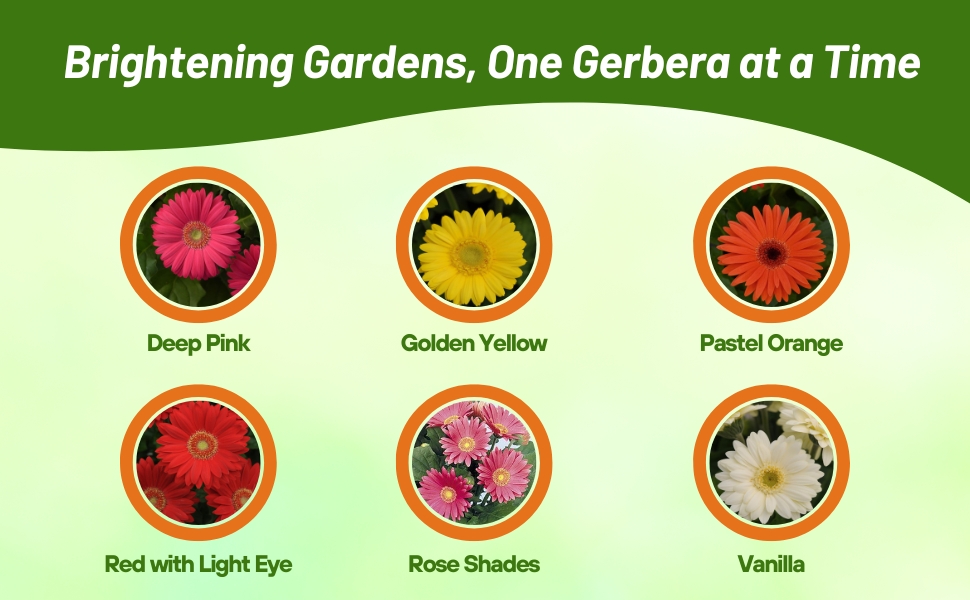
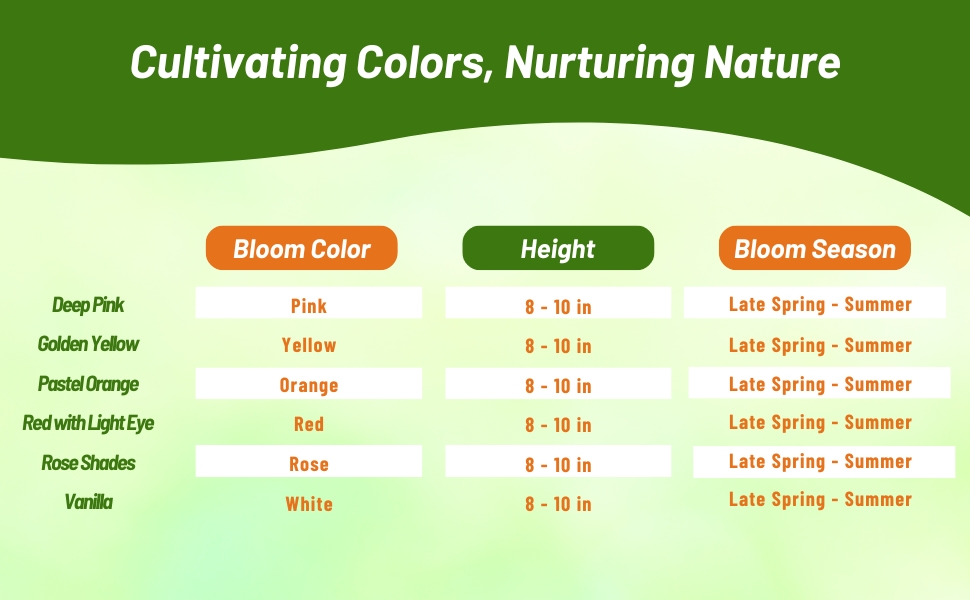
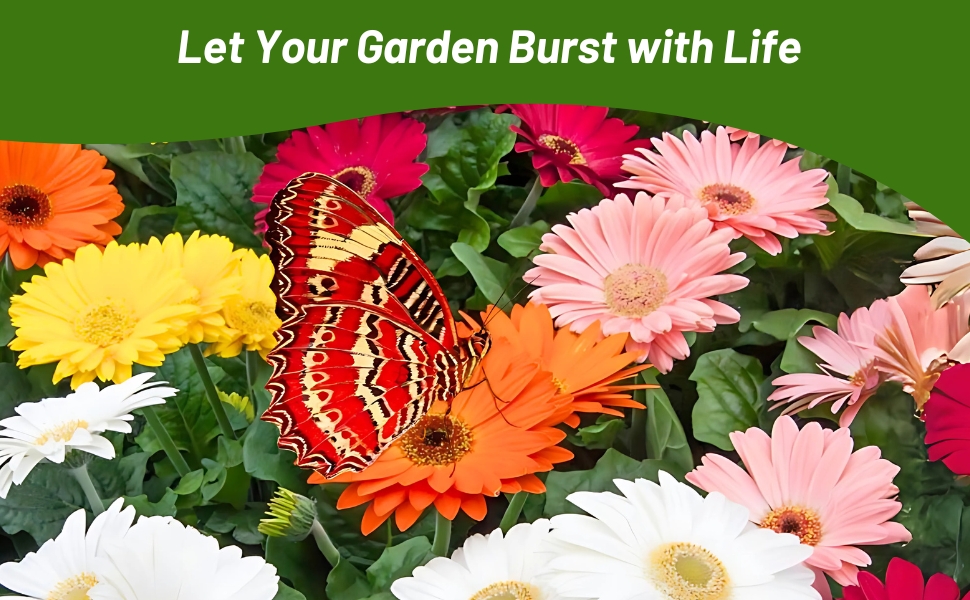
Gerbera Daisy (Gerbera Jamesonii Revolution Vanilla) - Grown from Gerbera seeds, this Gerbera Daisy plant is a native to South Africa. Gerbera Jamesonii plants are perennial in frost free zones, but can easily be grown as annuals in colder climates. This white Gerbera Daisy flower is so sweet and lovely. Grow it in the house in a sunny south window. As a house plant, Gerbera Daisy plants can bloom for about 6 weeks.
Gerbera Jamesonii plants are a good bedding item, and of course a mainstay of the cutting garden. The Gerbera Daisy flower loves full sun or partial shade and appreciates deep, rich soil. Therefore, working in compost and other organics is helpful, and keep the soil evenly moist.
Sow Gerbera Daisy seeds indoors 10 weeks before the last frost. Use starter trays and sterile potting mix. Place the pointed end of the flower seed down when sowing, and barely cover the seeds as they need light to germinate. Transplant outdoors once danger of frost has passed. You may also sow Gerbera Daisy seed directly outdoors when soil temperatures are warm. Gerbera Jamesonii care includes removing the spent blooms and stems as well as applying a liquid, balanced fertilizer every other week throughout the blooming season.
Common Questions
Can Gerbera daisies be grown indoors?
Gerbera daisies are commonly initiated indoors from seeds, but they thrive best when grown outdoors in the long run, requiring plenty of sunlight and nutrient-rich soil. Although Gerbera daisies are occasionally presented as potted gifts, they usually do not have a long lifespan or bloom repeatedly.
Are Gerbera daisies easy to grow?
Gerbera daisies can thrive outdoors with proper care. To grow them successfully, it's essential to monitor their water, light, and soil conditions diligently.
My plants are getting excessively bushy, what can I do?
If foliage is getting too bushy, remove some of the clustered center leaves to let in more sunlight.
How get I get my gerbera to give me more blooms?
Fertilizing your plants every 2 weeks with a high phosphorus, bloom boosting fertilizer can help. If you are amid summer the heat can suppress blooms, try moving them indoors until the hot weather passes.
My leaves are turning yellow, why?
Yellowing of lower leaves or the discoloration of plant tissue between green veins is often a sign of iron deficiency, which can impact flower production. This deficiency may stem from insufficient iron in the soil or fertilizer, or a soil pH above 6.2. Factors like temperatures below 68 degrees F, waterlogged soil, and unhealthy roots can also hinder nutrient absorption. Monitor temperatures, soil moisture, pH levels, and root condition to identify the underlying issue. Adjust soil pH if necessary or introduce iron chelates. Remember to avoid overwatering to maintain plant health.
Do I need to prune my gerbera plants?
Deadheading will extend your bloom season. As blooms fade, deadhead or prune the flower stems to the leaves where they emerge. Also to keep your plants looking tidy and encourage new leaf growth, pinch or trim older fading leaves.
Planting Directions
TEMPERATURE
70F
AVERAGE GERM TIME
10 - 21 days
LIGHT REQUIRED
Yes
DEPTH
Seeds must be covered thinly, no more than the thickness of the seed
SOWING RATE
2 - 3 seeds per plant
MOISTURE
Keep seed moist until germination
PLANT SPACING
10 - 15 inches

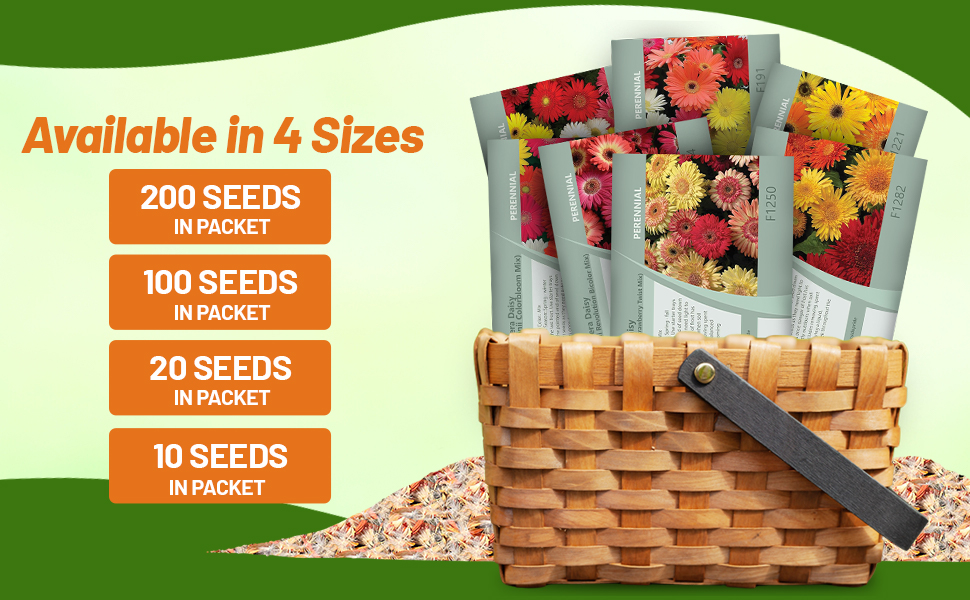
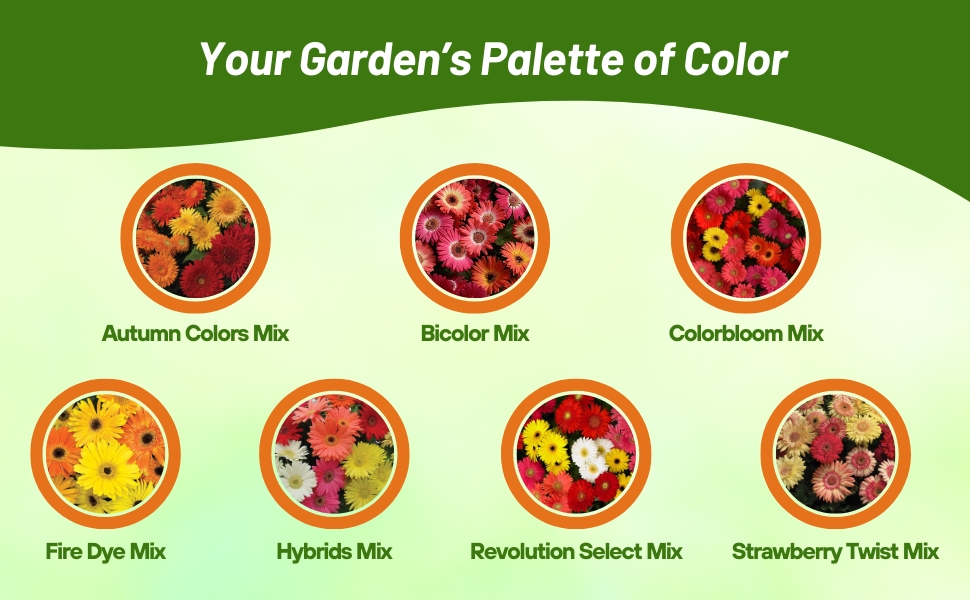
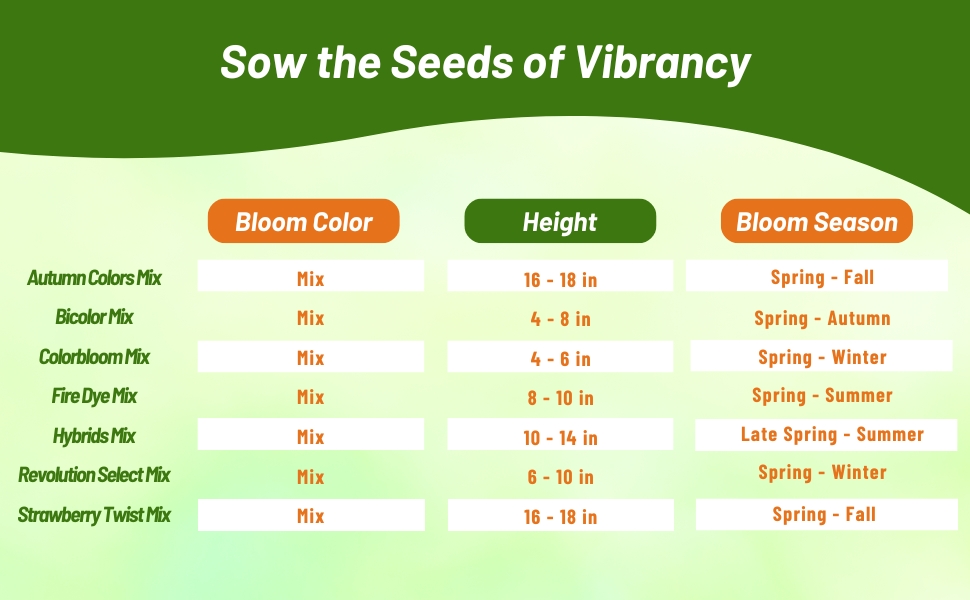

Gerbera Daisy (Gerbera Jamesonii Cartwheel Autumn Colors Mix) - Grown as a perennial in frost free zones, but can easily be grown as annuals in colder climates. This flower mix is so sweet and lovely. Grow it in the house in a sunny south window. As a house plant, these daisies can bloom from early Spring in to Autumn.
Gerbera Jamesonii plants are a good bedding item, and of course a mainstay of the cutting garden. The Gerbera Daisy flower loves full sun or partial shade and appreciates deep, rich soil. Therefore, working in compost and other organics is helpful, and keep the soil evenly moist.
Sow Gerbera Daisy seeds indoors 10 weeks before the last frost. Use starter trays and sterile potting mix. Place the pointed end of the flower seed down when sowing, and barely cover the seeds as they need light to germinate. Transplant outdoors once danger of frost has passed. You may also sow Gerbera Daisy seed directly outdoors when soil temperatures are warm. Gerbera Jamesonii care includes removing the spent blooms and stems as well as applying a liquid, balanced fertilizer every other week throughout the blooming season.
Common Questions
Can Gerbera daisies be grown indoors?
Gerbera daisies are commonly initiated indoors from seeds, but they thrive best when grown outdoors in the long run, requiring plenty of sunlight and nutrient-rich soil. Although Gerbera daisies are occasionally presented as potted gifts, they usually do not have a long lifespan or bloom repeatedly.
Are Gerbera daisies easy to grow?
Gerbera daisies can thrive outdoors with proper care. To grow them successfully, it's essential to monitor their water, light, and soil conditions diligently.
My plants are getting excessively bushy, what can I do?
If foliage is getting too bushy, remove some of the clustered center leaves to let in more sunlight.
How get I get my gerbera to give me more blooms?
Fertilizing your plants every 2 weeks with a high phosphorus, bloom boosting fertilizer can help. If you are amid summer the heat can suppress blooms, try moving them indoors until the hot weather passes.
My leaves are turning yellow, why?
Yellowing of lower leaves or the discoloration of plant tissue between green veins is often a sign of iron deficiency, which can impact flower production. This deficiency may stem from insufficient iron in the soil or fertilizer, or a soil pH above 6.2. Factors like temperatures below 68 degrees F, waterlogged soil, and unhealthy roots can also hinder nutrient absorption. Monitor temperatures, soil moisture, pH levels, and root condition to identify the underlying issue. Adjust soil pH if necessary or introduce iron chelates. Remember to avoid overwatering to maintain plant health.
Do I need to prune my gerbera plants?
Deadheading will extend your bloom season. As blooms fade, deadhead or prune the flower stems to the leaves where they emerge. Also to keep your plants looking tidy and encourage new leaf growth, pinch or trim older fading leaves.































